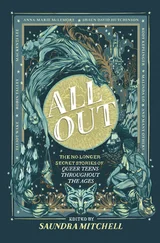Down in the lobby, the police were starting to cuff and take away the rioters, though some were still breaking and dismantling the furnishings. Below me a woman was sitting on the floor, holding her head, looking dazed. A man, perhaps her husband, tried to comfort her. I thought about my niece, how on earth it might have been for her as she fell from the eighth floor of the library in town — to which she had the key because she volunteered there twice a week — how she must have known at some point that the parachute was not going to save her and how entirely alone she must have been. I felt something like a wave of molten lava rising up inside my body and I tried to tamp it down as I had done many times before, keeping a careful hold of myself so that I could report objectively on all that had occurred. But I did not succeed this time, and the great, hot mass welled up out of my chest and came out of my mouth as a sound I’d never heard myself or anyone else make until that moment and before I knew what I was doing, I found that I was running down the wide, carpeted staircase, with my fists swinging out in front of me, still shouting without words and looking, looking, looking for something, anything to smash.
1.
Emily Mitchell was born in London in the middle of a garbage collectors’ strike. The strike began when the year had just crawled out from winter and it was still cold and rainy and the garbage collectors were unhappy because exponential growth in the manufacture and use of disposable food containers had added to their workload but there had been no expanded hiring to meet this increased demand. The leader of their union was a charismatic man called Donkey who got his moniker for his very long ears and braying voice as well as for his stubborn nature, although it is worth noting that Donkey, whose real name was Clive, was also a father and husband whose wife and children remember him as very kind, gentle and patient.
All spring the garbage piled up against the walls of the city. Fruit and scraps of meat dampened and drooped; vegetables blackened, frayed, disintegrated. Bristling animals slipped in and out of the mounting piles of plastic bags and bottles, beverage cartons, tin cans, old shoes. Children had to be warned not to play and climb on the heaps of refuse clogging up the streets, but some nevertheless made games of running up their sides and some of them fell into the piles of trash and had to be rescued. In places around town, whole streets were blocked and traffic had to be diverted.
In the end, the government decided to settle with the garbage collectors, but by this time the mountains of trash were so high and so dense from the pressures of the layers above that they could not be moved by the normal means. In some places the city used helicopters to dislodge the mass of compacted matter and hoist it into the air so that it could be flown away. People who were alive at that time remember from that summer the frequent spectacle of fleets of helicopters flying across the sky, each with a misshapen mass attached beneath it on the end of a long cord, silhouetted against the setting sun. As picturesque as these flights were, they had the disadvantage that the masses of garbage would lose their integrity in flight and start to shed, showering the populace below with banana peels and old chocolate-bar wrappers.
By the time Emily Mitchell was born, in the fall of that year, most of the garbage had been cleared away. Some of it had been buried and the land above turned into parks. Some of it had been moved to a secret location. The strike was over and the growling trucks moved again through the blue early streets waking people before dawn.
One surprising after effect of the strike was not discovered until the following year. It was found that several species of insects, including a variety of butterfly, and some types of flowering plants — a ragweed, a tasslewort — had begun to adapt to the garbage mountains even in the short time they existed. These insects and plants had changed their colors and in some cases their shapes in order to camouflage themselves more effectively and had come to mimic the prevalent designs found in their new environment. The bold red-and-white design of the Coca-Cola can in particular seems to have inspired these adaptations, and several of the plants began to select for a mutation of brilliant scarlet with white curlicues. Even today, these flowers can be seen growing wild in unexpected places around the city. They are deemed rare and desirable and expensive — when they can be found. Efforts to raise them commercially have not been successful. So if you can locate them, you can sell them for a remarkable sum.
2.
Emily Mitchell has worked as a waitress, a receptionist at a bakery/tanning salon, a short-order cook, a snowmobile driver, a crime-scene cleanup technician, an exotic animal trainer, a war correspondent, a phone dispatcher, a secretary, an environmental campaigner, a freelance journalist, a bean counter and a holistic pediatric oncologist.
She has never worked as an exotic dancer. She might have done this — since she has no moral objection to sex work as such and certainly not to the deliberate and conscious choice by women to use their sexual desirability, long the source of their unjust and egregious oppression, as a means of obtaining economic and social power — if only her breasts had been bigger. Not much bigger, but big enough that they appeared large in proportion to her torso, which seems to be the important ratio in these cases. Or maybe it was her torso that was too big. Or her hips, which are round and scoop-shaped, so her body is like a tulip bulb or an old-fashioned earthenware jug. She thinks she might have been pretty good at exotic dancing, actually, if not for her overwhelming self-consciousness, her basic discomfort with disrobing in front of people with whom she’s not intimate, her physical clumsiness and her inconvenient but persistent sense that there is something exploitative about the whole endeavor.
She obtained a joint degree in neuroscience and engineering from the American University of Southern Abkhazia and a master of fine arts from the Iowa Writers’ Workshop. She taught English in Japan for several years but was fired when it was discovered that she had been deliberately teaching her students a dialect entirely of her own invention because she thought it would be “amusing” to create a group of people who spoke a wholly imaginary language without being aware of it. She said, in a statement at the time of her termination: “I wanted to make something beautiful and aloof, a language that floated in the world with the levitating detachment of a cumulus cloud. I had only the best intentions and I am sorry for anyone whom I have hurt.” At the end of her statement she added several sentences in her invented language, which no one except one or two of her more advanced students understood and which they would not translate when asked for comment. After that she was led away and deported.
3.
Emily Mitchell’s first novel The Art Historian’s Daughter-in-Law was published in 2009 and was almost entirely plagiarized from the work of the nineteenth-century Norwegian novelist Amund Eilertsen. She was immediately sued by the Eilertsen estate for copyright infringement but argued successfully that, because she stole material from more than one of Eilersten’s novels, her book constituted an entirely new work of literature that crucially reframed and reimagined the content of the original and therefore was a legitimate contribution to the intellectual conversation of our time. She is now working on a novel that combines excerpts from the works of George Eliot with lyrics by the Rolling Stones.
Her short fiction has appeared in various publications and then disappeared. This is unusual and seems to be attributable to a peculiar warp in the space-time continuum, which her work has caught like a virus and which makes it vanish shortly after publication never to be seen again. There were recently rumors that some of her stories had inexplicably turned up in a computer seized by police in Harare, Zimbabwe, but these are uncorroborated and may in fact have been a hoax perpetrated to generate publicity for her forthcoming novel.
Читать дальше












